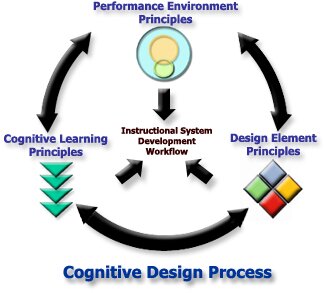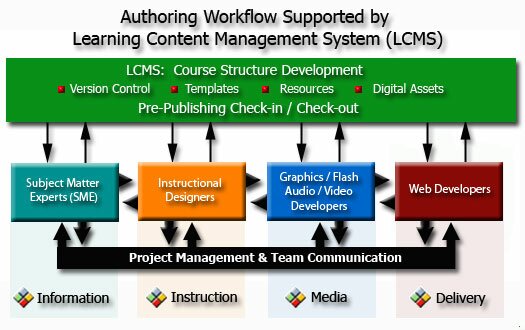|
 Design Process > What is Cognitive Design? Design Process > What is Cognitive Design?
What is Cognitive Design?
Cognitive Design is an instructional design process that focuses on cognitive principles of learning. It augments the traditional instructional system design (ISD), which is a procedural-workflow model, with a principle-based methodology. The goal is to construct E-Learning products and activities that are "Learner-Centric."
The cognitive design process provides a rational framework for the instructional development lifecycle. The goal is to support effective product development as well as efficient project management. It focuses on the instructional decisions related to the use of:
- Performance Improvement Environments: Knowledge Management, E-Learning, and Performance Support
- Four Key Design Elements: Information, Instruction, Media and Delivery System
- Principles of Cognitive Learning: Multimedia Learning, Management of Cognitive Load, Interactive Engagement and Performance-based Instruction.

Principle-based Instructional Design
This section will focus on the application of the model in design process — reviewing the practical issues of principle-based instructional design:
- The model presents thee Performance Improvement Environments: Knowledge Management, E-Learning and Performance Support, as a means of identifying the type of intervention strategy which is most appropriate: Inform, Instruct and Guide. Does the learner need information? Does the learner need instruction? Does the learner need guidance?
On the basis of that need, the infrastructure that delivers these learning solutions is evaluated to determine if it is viable: What barriers need to be overcome? What constraints need to be accommodated? What strategic and tactical infrastructure is available?
-
The model asserts that E-Learning products and activities are built from four interlocking elements: Information, Instruction, Media, and Delivery System. These four design elements are used to define the instructional integrity of an E-Learning product or activity — in terms of unified and interfaced learning structures.
- Principles of cognitive science are used to evaluate the instructional effectiveness and integrity of these design elements — individually and together. A detailed overview of these learning principles is presented in the next section, "Cognitive Design Principles."
-
The design process involves a checklist of design criteria (based on the cognitive design principles) to be used throughout the product development and project management lifecycle — to assure that quality instructional design occurs. A detailed overview of this is presented in the section, " The Process Paradigm."

- A project manager or instructional designer uses the four design elements to define task clarity, and to ensure the application of the cognitive design principles in each component. Additional details are presented in the section on, "Workflow."

- Finally, the design process initiates and maintains an approach to instructional planning, design, development, implementation, and evaluation that is "Learner Centric." A primary goal of E-Learning products and activities is to be centered on learning issues, rather than technology, instructor or project management issues. How to work toward this "value formula" is elaborated in detail in the section called, "Design Thinking."
Additional information is also available in the section entitled "The Cognitive Design Model." It explores the use the Cognitive Design Model to plan and implement a "Learning Organization" strategy — addressing the global issue of integrating enterprise, team and individual learning solutions.
What are the Benefits?
The framework of the Cognitive Design Process is intended as a mental model to simplify planning, project management, evaluation, and communication:
- Reduce the complexity of E-Learning construction to four fundamental design elements, and relate design decisions to cognitive principles
- Keep all instructional development focused on learner's results
- Establish a holistic / systems thinking view that appreciates: "the whole is greater than the sum of the parts", "the parts are not inter-changeable" and "no single part is the whole"
- Enforce clarity and understanding of the learning structures:
- Information is NOT Instruction
- Media is NOT Instruction
- Delivery System is NOT Media
- Instructional Strategy is NOT Delivery System
These are common confusions, especially for non-professionals. However, those engaged in the design process are often not clear about these distinctions either— unable to differentiate the structures in terms of their intended effect upon the learner and the important cognitive processes involved.
For instance, a single HTML page within an online course may often include Information, Instruction, Media, and Delivery System elements. The "soundness" of design must be viewed from these four fundamental learning structures: first, in terms of the whole lesson or course, and then how component pages contribute to achieving the desired effect. How is a page is constructed? How does it relate to other pages of presentation and interaction of the lesson or course? How does the learner respond to each structure individually and together? All this is what determines if it is a sound E-Learning product that supports an effective and efficient learning experience.
"Information, Instruction, Media and Delivery System" provides a simple heuristic device: a communication tool for project manager, instructional designer, developers, and subject matter experts to be clear with each other about what is being built, evaluated, or integrated at any particular moment.
Substance, not Surface
The importance of using a model, a framework of processes and principles, to establish clarity cannot be overstated. Clarity is often lacking because good instructional design tends to be complex. It is often easier to focus on technology or on surface appearance — "eye-candy" or "sizzle" — rather than on building instructionally meaningful, integrated and impactful products.
The Cognitive Design framework seeks to anchor sound design mechanics. It does this by focusing on the design decisions related to the four key design elements: Information, Instruction, Media and Delivery System. While ADDIE defines the project workflow phases, the four design elements define the 'substance' of the instructional design decision process. The model keeps the team focused on and using the cognitive design principles throughout the planning and build phases — as design criteria and as the basis for performance evaluation.
The Cognitive Design Process framework is used continually to direct attention back to the substantive issues of learning structure and cognitive design principles. For example, a development team may spend time building innovative "user interfaces" (for the learner's ease of use), or rapid development "templates" (for the instructor's ease of authoring). But these are not ends in themselves. They only have educational value or validity in terms of the larger structures in which they reside: How does a UI or template decision effect instructional effectiveness and structural integration of the four key elements? Are specific UI or template design decisions in alignment with key cognitive design principles being used as evaluation criteria?
Conclusion
In summary, the Cognitive Design Process is a principle-based model of instructional design, which aims at producing the following quality characteristics:
- Learner-centric — stay focused operationally on the cognitive issues of the learner; prevent project management, instructor, or technology issues from subordinating the learner issues
- Holistic -- see the distinct levels of structure which must be built into an effective e-learning product
- Systems-thinking — clarify components of the instructional product, and how these deeper structures interrelate
- Structural integrity — use the structural definition of the four design elements as a way to establish boundaries, and prevent design from becoming "one-sided" — excessively influenced by passing fads or use of the newest technology — regardless of their instructional merit
- Instructionally sound — use a simple set of cognitive-behavioral learning principles to constantly monitor the instructional integrity of the build

|
|
 |
What is Cognitive Design? |
 |
|
|



